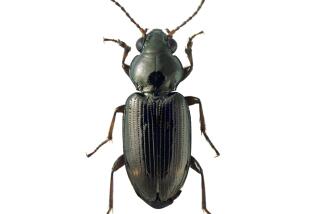Meet the Lord of the Wasps : Hobbies: Harry Andersen has researched the tiny insects for almost 40 years, and it’s a labor of love.
- Share via
HUNTINGTON BEACH — Choosing names for his three new babies wasn’t a difficult task for Harry Andersen.
First there was H. tahoensis Andersen, born on the Fourth of July in 1987 when the 65-year-old Huntington Beach resident and his wife were vacationing at Lake Tahoe. Then came H. magnistipes Andersen, christened in early 1990. And finally there was H. altiverticalis Andersen, who debuted directly afterward.
The three additions to the Andersen family aren’t human, though; they’re bugs. And they were finally made official last October when Pan-Pacific Entomologist, an occasional scientific journal devoted solely to insects, published an article by Andersen that identified them as wasps belonging to previously unrecorded species. According to scientific protocol, all three bear the name of their founding father, Andersen.
“They’re just gorgeous creatures,” he says rapturously as he peers at a perfectly preserved specimen through his $4,500 stereoscopic microscope. Magnified nearly 50 times, the wasp shows off its teal-blue metallic sheen and transparent but finely veined wings. “To me they’re beautiful. It’s a joy to look at them.”
But these aren’t your usual garden-variety wasps, the ones that sport yellow-and-black-striped jackets and leave vicious little stings as calling cards. The wasps Andersen studies rarely measure more than two or three millimeters across--about the size of a pinhead--and carry stingers that couldn’t penetrate human skin if they tried. Their average life span is only a few months, and their most important activity is mating.
Andersen, a lean, robust retiree, has been studying the insects in earnest since stepping down from a career as a high school administrator four years ago. He spends 30 to 35 hours a week at home gazing at, marveling over and measuring the insects, or chalcids, as they’re known in scientific circles. And he boasts one of the largest private collections in the country, with an upstairs “bugroom” stacked with trays full of specimens on loan from museums and universities across North America.
“I don’t think anyone else probably knows near as much as he does about these (insects),” says Gary James, dean of math and science students at Orange Coast College, where Andersen teaches a biology course one night a week. “This is in the classic tradition of England where a lot of the first-class natural history research is done by amateurs.”
Andersen’s interest in chalcids traces back to his graduate years at the University of Illinois at Urbana. A biology major as an undergraduate, he credits his master’s thesis adviser with putting him onto the chalcid track in the early 1950s.
“He introduced me to them, and I fell in love right off--like that,” Andersen says, snapping his fingers. “He’s been long dead, bless his heart, but I actually still have some of his specimens.”
Although Andersen spent the next 30 years working in education and raising five children, he never forgot his first love. Retirement offered him the chance to jump back in with greater zeal than ever.
“I’m more excited today than I was then,” Andersen says, darting from one corner of his bugroom to another in search of materials. “I love doing it. I have never had to force myself to sit down and work.”
Most days he spends hunched over his microscope in the bugroom of his condominium, taking measurements and making drawings of some of the thousands of chalcid specimens surrounding him. Lunch is usually a simple affair of a grapefruit eaten over the kitchen sink. On weekends he’ll drive out to UC Riverside, where he is a research associate, to use their high-tech equipment.
His work even follows him on vacation. The specially designed net he uses to catch the wasps accompanies him everywhere, from islands off Australia to islands in the Caribbean. And it was while he was on holiday at Lake Tahoe over the Fourth of July weekend a few years ago that he netted Halticopterina tahoensis Andersen, the first of the three new species Andersen has discovered.
The H. tahoensis sports antennae with three ring segments rather than the usual two--a big enough structural difference to merit its own species designation.
“I was pretty excited when I realized what I’d found,” Andersen says. “But I didn’t run out into the street and yell, ‘Eureka,’ because the (neighbors) would have gone, ‘He’s crazy enough as it is!’ ”
The other two species that were logged into the entomological world last October are of the same genus as the H. tahoensis . Andersen discovered them, lying unstudied, in a tray on loan from the United States National Museum.
For the past three years Andersen has been working diligently on his magnum opus : a complete revision of the genus Halticoptera, another branch of the chalcid family. Already he has amassed three thick binders full of drawings and carefully written notes. And after his 100-odd-page paper is published sometime next year, he predicts that he’ll have at least 15 more species named after him.
“That’ll be my big shot in life,” he jokes.
Andersen is quick to thank his wife of 42 years, Dodie, who has encouraged him throughout his research--without exactly offering to help.
“She’s a sweetheart. But she says, ‘You see ‘em, you kill ‘em, you got ‘em, you take care of ‘em.’
“Nobody (else) in my family has my interest in bugs,” he says, adding almost wistfully, “It would’ve been nice to have one bug person in the family.”






